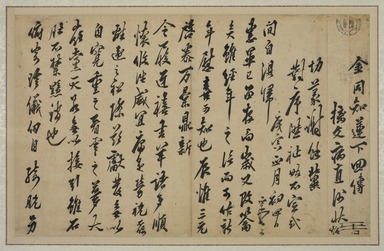
Artist:Gim Jeong-hui
Medium: Ink on paper
Geograhical Locations:
Dates:1830
Dimensions: frame: 20 3/4 × 32 3/4 × 1 1/4 in. (52.7 × 83.2 × 3.2 cm)
Collections:
Accession Number: 2022.37.4
Image: 2022.37.4_PS11.jpg,
Catalogue Description: Letter written in loose, cursive but legible Chinese characters, on a horizontally oriented sheet of paper, formerly folded at the center, now matted and framed. Letter consists of 17 vertical lines of script with an old stamp at the top right. Contents have been translated: "I found your letter dated last year when I came back from P'yong Yang recently. Although it was last year's, your news brightens up the new year, and I understand how happy you must be. It's the first month of the year and everything seems refreshed. Your future is auspicious, your words and thoughts calm and orderly, and you are just and magnanimous in everything you do. Much congratulations. I greeted the new year in a foreign land, feeling anxious as I would feel at the prospect of being separated from my parents. Furthermore, knowing that I can not see my younger brothers and sisters hurts me so much that even if my heart were made of stone, it would melt. I appreciate very much the food you sent me. I know that it was sent with much care. I shall write to you from time to time. For now, I bid you a happy New Year." Translation courtesy of Professor Edward W. Wagner, Korea Institute, Harvard University Gim Jeong-hui (alternate names Wandang and Chu'sa) was a great calligrapher and literatus during the last decades of the Joseon period. He was a member and founder of the Chusa school of scholarship (named after his sobriquet) which modeled itself on the Chinese Southern school. He traveled to China as a young man, and his calligraphy style refers to Chinese eccentrics and to Chan Buddhist forms.